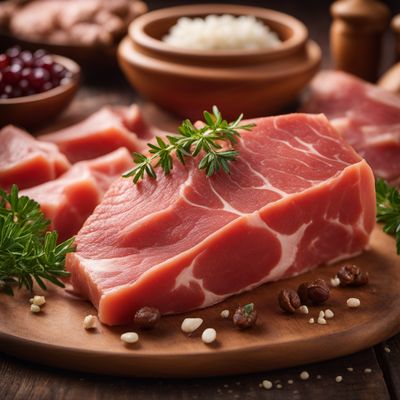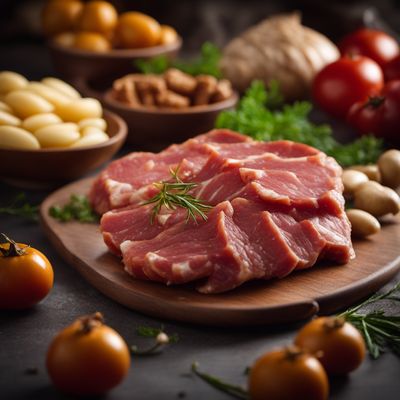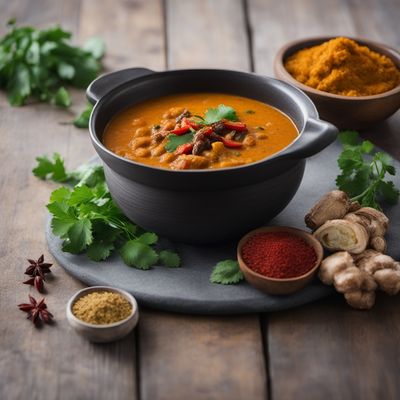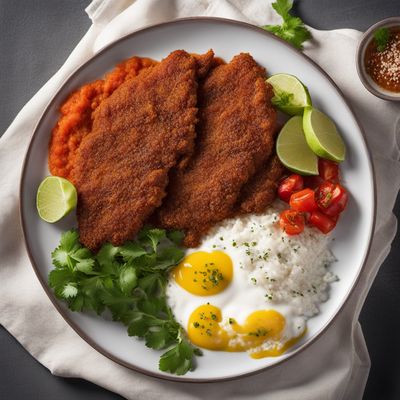
Ingredient
Llama or lama fresh meat
"The Exotic Delicacy: Discover the Unique Flavors of Llama Meat"
Llama meat is lean and tender, with a flavor that can be described as a cross between beef and lamb. It has a slightly sweet and earthy taste, with a hint of gamey undertones. The meat is typically dark red in color and has a fine texture, making it suitable for a variety of culinary preparations. Llama meat is known for its low fat content and high protein levels, making it a healthy choice for those seeking a nutritious alternative to traditional meats.
Origins and history
Llama meat has been consumed for centuries in the Andean regions of South America, where llamas are native. These animals have played a significant role in the culture and economy of the Andean people, providing not only meat but also wool and transportation. Llama meat was traditionally enjoyed by indigenous communities and has gradually gained recognition in international cuisine.
Nutritional information
Llama meat is a good source of protein, iron, and vitamin B12. It is also low in fat and cholesterol, making it a healthy choice for those looking to maintain a balanced diet.
Allergens
Llama meat does not commonly cause allergies, but individuals with a history of red meat allergies should exercise caution.
How to select
When selecting llama meat, look for cuts that are bright red in color, firm to the touch, and free from any unpleasant odors. The meat should have a fine marbling of fat, which adds flavor and tenderness. If purchasing from a farmers market, inquire about the animal's diet and how it was raised to ensure the best quality.
Storage recommendations
Llama meat should be stored in the refrigerator at a temperature below 40°F (4°C). It is best to consume it within 2-3 days of purchase or freeze it for longer storage. To freeze, wrap the meat tightly in plastic wrap or place it in an airtight container to prevent freezer burn.
How to produce
Llama meat production is typically carried out by experienced farmers who raise llamas for meat. It requires specialized knowledge and facilities, making it less suitable for amateur production.
Preparation tips
Llama meat can be prepared using various cooking techniques such as grilling, roasting, or braising. It is important to cook it to the recommended internal temperature of 145°F (63°C) to ensure food safety. Marinating the meat before cooking can enhance its flavor and tenderness. Llama meat pairs well with bold spices, herbs, and marinades, allowing for a wide range of culinary creations.
Culinary uses
Llama meat is commonly used in traditional Andean dishes such as anticuchos (grilled skewers), stews, and empanadas. It can also be used as a substitute for beef or lamb in various recipes, adding a unique twist to familiar dishes.
Availability
Llama meat is most commonly available in South American countries such as Peru, Bolivia, and Ecuador. It can also be found in select specialty meat markets or online retailers catering to international cuisines.
More ingredients from this category » Browse all

Chamois fresh meat
The Wild Delicacy: Exploring the Flavors of Chamois Fresh Meat

Wild boar fresh meat
The Untamed Delicacy: Wild Boar Fresh Meat

Deer fresh meat
"The Wild Delicacy: Exploring the Rich Flavors of Deer Fresh Meat"

Sheep fresh meat
The Savory Delight of Sheep Fresh Meat

Hare fresh meat
The Wild Delicacy

Rat meat
"The Unconventional Delicacy: Exploring the World of Rat Meat"

Equine fresh meat
The Gastronomic Delight of Equine Cuisine

Bovine and pig fresh meat
The Butcher's Bounty: Exploring Fresh Bovine and Pig Meat

Mixed pork and mutton/lamb fresh meat
The Perfect Blend: Pork and Lamb Combination

Marine mammals meat
Delicacy from the Deep Blue

Rabbit fresh meat
The Versatile Bunny

Camel fresh meat
The Exotic Delicacy: Camel Meat
Recipes using Llama or lama fresh meat

Curried Alpaca Stew
Andean Delight: Curried Alpaca Stew with Traditional Inca Flavors

Peruvian Alpaca Schnitzel
Andean Delight: Crispy Alpaca Schnitzel with Peruvian Flair

Tuscan-style Llama Stew
Tuscan Llama Delight: A Hearty Stew with a Tuscan Twist

Montenegrin-style Breaded Alpaca Cutlets
Savory Delight: Montenegrin Breaded Alpaca Cutlets

Peruvian Lomo de Llama with Aji Amarillo Sauce
Andean Delight: Tender Lomo de Llama with Spicy Aji Amarillo Sauce

Bolivian-Style Stuffed Buns
Andean Delights: Bolivian Stuffed Buns with a Twist

Bolivian Llama Stew
Andean Delight: Bolivian Llama Stew with Quinoa and Spices